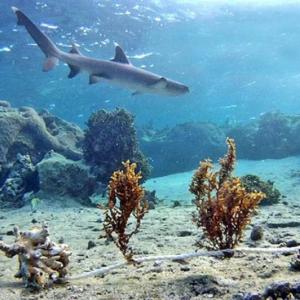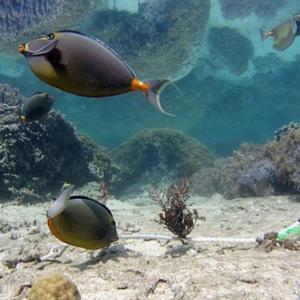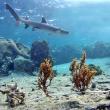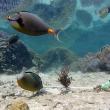Bigelow researcher discovers fishes' fear of sharks shapes Fijian reefs
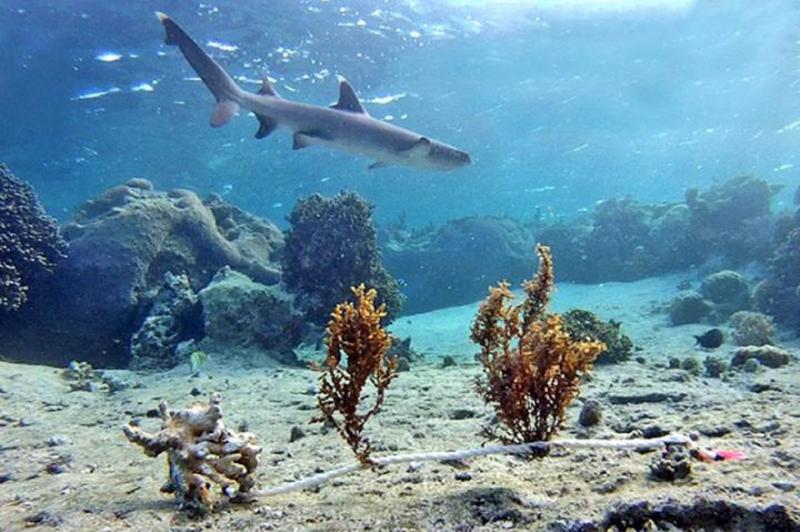 A whitetip reef shark patrols a Fijian coral reef lagoon at high tide. In a recently published study, researchers from Bigelow Laboratory documented the first clear example of sharks causing cascading changes among other sea life in this ecosystem. Courtesy photo
A whitetip reef shark patrols a Fijian coral reef lagoon at high tide. In a recently published study, researchers from Bigelow Laboratory documented the first clear example of sharks causing cascading changes among other sea life in this ecosystem. Courtesy photo
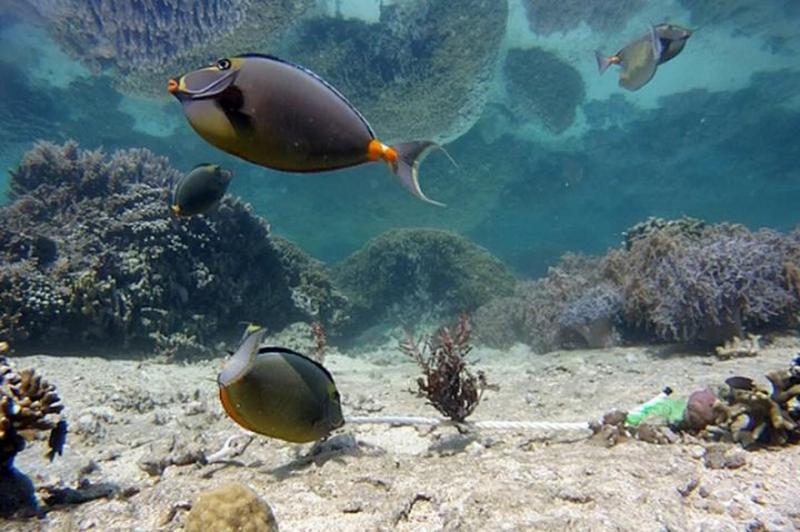 An orange spine unicorn fish feeds on a seaweed experiment in a Fijian coral reef lagoon at low tide. In a recently published study, researchers from Bigelow Laboratory documented the first clear example of sharks causing cascading changes among other sea life in this ecosystem. Courtesy photo
An orange spine unicorn fish feeds on a seaweed experiment in a Fijian coral reef lagoon at low tide. In a recently published study, researchers from Bigelow Laboratory documented the first clear example of sharks causing cascading changes among other sea life in this ecosystem. Courtesy photo
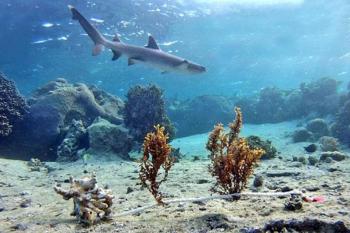 A whitetip reef shark patrols a Fijian coral reef lagoon at high tide. In a recently published study, researchers from Bigelow Laboratory documented the first clear example of sharks causing cascading changes among other sea life in this ecosystem. Courtesy photo
A whitetip reef shark patrols a Fijian coral reef lagoon at high tide. In a recently published study, researchers from Bigelow Laboratory documented the first clear example of sharks causing cascading changes among other sea life in this ecosystem. Courtesy photo
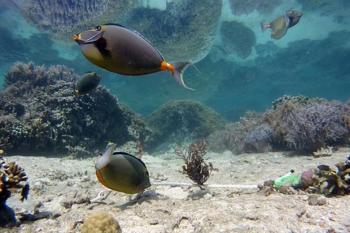 An orange spine unicorn fish feeds on a seaweed experiment in a Fijian coral reef lagoon at low tide. In a recently published study, researchers from Bigelow Laboratory documented the first clear example of sharks causing cascading changes among other sea life in this ecosystem. Courtesy photo
An orange spine unicorn fish feeds on a seaweed experiment in a Fijian coral reef lagoon at low tide. In a recently published study, researchers from Bigelow Laboratory documented the first clear example of sharks causing cascading changes among other sea life in this ecosystem. Courtesy photo
Fishes' fear of sharks helps shape shallow reef habitats in the Pacific, according to new research by a scientist at Bigelow Laboratory for Ocean Sciences.
The study is the first clear case of sharks altering a coral reef ecosystem through an indirect effect - creating an atmosphere of fear that shifts where herbivores feed and seaweeds grow. Referred to as a trophic cascade, these complex relationships exist throughout nature but the linkages are often hard to identify.
The study, published in Scientific Reports, looked at reefs located along the coast of Fiji. Many of its islands are surrounded by shallow, intertidal reefs that are commonly found in the Pacific. Through environmental monitoring and experiments, the research team found that sharks alter the feeding behavior of algae-eating fish in the ecosystem. This change reverberates down the food chain to affect where seaweed, a chief competitor to corals, grow on the reef.
"Although sharks are charismatic predators that capture the interest of many, we still only have a very basic understanding of their ecological roles in nature," said Doug Rasher, a senior research scientist at Bigelow Laboratory and lead author of the new paper. "This is the first location where we've determined that sharks are not just a passenger in the ecosystem but actually shape the way it looks and functions."
In environments all over the world, fear of predators can greatly alter the feeding behavior and movements of herbivores. However, understanding the full impact of those effects on an ecosystem can be difficult. This is especially true with large predators like sharks that cover long distances, feed infrequently, and consume a variety of prey. These predators can't be effectively studied through traditional approaches, and their impacts are naturally diffused across locations and times.
To get around these challenges, this study utilized a narrow focus. The researchers honed in on a small number of species that were most likely to be involved in a trophic cascade - the most common seaweeds, the fish that consume them, and reef sharks that primarily feed on fish.
The research team, which included scientists from James Cook University and Georgia Institute of Technology, also focused on the reef habitat most likely to foster a trophic cascade: the shallow intertidal habitat. At high tide, this region is accessible to predators found in the nearby deeper waters. Sharks and other large predators make predictable hunting trips into the shallows during this time. At low tide, the area becomes a series of lagoons that are isolated from the greater seascape, making it a haven from predators.
"The threat of predation is a powerful force in nature," Rasher said. "Every animal on the planet would rather miss lunch than be lunch, so their actions often reflect that sentiment."
The confluence of terrain and tide in the shallow reefs created a predictable cycle of risk. The study revealed that herbivorous fish greatly preferred to feed at low tide in the isolated lagoons, when predators were absent and the threat of predation was low. This kept seaweeds at a minimum in those areas but allowed them to flourish on the very top of the reef, which was only accessible during high tide when predators patrolled the area.
"The ecological importance of sharks remains a contentious topic, but here we've shown that they can cause trophic cascades under select conditions," Rasher said. "We need to refocus the conversation away from whether trophic cascades generally exist and toward identifying the specific times and places that sharks shape the environment around them."
Event Date
Address
United States

